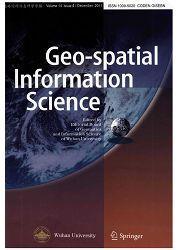Assessing multi-spatial driving factors of urban land use transformation in megacities: a case study of Guangdong–Hong Kong–Macao Greater Bay Area from 2000 to 2018
IF 4.4
1区 地球科学
Q1 REMOTE SENSING
引用次数: 0
Abstract
Rapid morphological and socioeconomic changes have accelerated the urbanization process and urban land use transformation in China. Megacities comprise clusters of urban cities and exhibit both newly formed and well-developed urban land use development beyond administrative boundaries. It is necessary to distinguish the changing effects of spatial-varying driving factors on newly formed urban land uses from well-developed built-up areas in megacities. This study proposed a multi-spatial urbanization framework to quantify region-level socioeconomics, cluster-level ecological morphologies, and grid-level urban functional morphologies. A three-level Bayesian hierarchical model was developed to investigate the impacts of multi-spatial driving factors on urban land use transformation in megacities. The study period focused on the urbanization process between 2000 and 2018 in Guangdong–Hong Kong–Macao Greater Bay Area (GBA). Results revealed that compared with well-developed urban built-up land, changing impacts of three-level driving factors in urban land use transformation could be captured based on the proposed Bayesian hierarchical model. The region-level total population was associated with increasing possibilities in forming new residential land than the well-developed ones in 35 districts/counties/cities in GBA. Cluster-level ecological attributes with higher proportion, lower edge density of urban built areas, and lower-degree ecological complexity showed increasing probability on newly formed industrial and public land. Grid-level urban functional factors including public transportation density and shopping/dining distribution exhibited significantly decreasing probability (coefficients: −2.12 to −0.51) on contributing newly formed land uses compared with the well-developed areas, whereas business/industry distribution represented higher (coefficients: 0.99 and 0.15) and lower probabilities (coefficient: −0.22) of forming industrial/public land and residential land separately. This research shows a new attempt to distinguish multi-spatial morphological and socioeconomic effects in urban land use transformation in megacities.特大城市土地利用转型的多空间驱动因素分析——以2000 - 2018年粤港澳大湾区为例
快速的形态和社会经济变化加速了中国城市化进程和城市土地利用转型。超大城市由城市集群组成,展示了超越行政边界的新形成和发达的城市土地利用开发。有必要区分空间变化驱动因素对特大城市建成区新形成城市用地的变化效应。本研究提出了一个多空间城市化框架,量化区域层面的社会经济、集群层面的生态形态和网格层面的城市功能形态。以特大城市为研究对象,建立了多空间驱动因素对城市土地利用转型的三层贝叶斯层次模型。本研究以2000 - 2018年粤港澳大湾区的城市化进程为研究对象。结果表明,与发达的城市建成地相比,基于贝叶斯层次模型的城市土地利用转型可以捕捉到城市土地利用转型中三个层次驱动因素的变化影响。大湾区内35个区(县/市)的人口总量与新住宅用地形成可能性均高于发达地区。城市建成区边缘密度高、边缘密度低、生态复杂程度低的集群级生态属性在新形成的工业用地和公共用地上出现的概率增加。与发达地区相比,包括公共交通密度和购物/餐饮分布在内的网格级城市功能因子对新形成土地利用的贡献概率(系数为- 2.12至- 0.51)显著降低,而商业/工业分布分别对工业/公共用地和住宅用地的贡献概率更高(系数为0.99和0.15)和更低(系数为- 0.22)。该研究为区分特大城市土地利用转型的多空间形态效应和社会经济效应提供了新的尝试。
本文章由计算机程序翻译,如有差异,请以英文原文为准。
求助全文
约1分钟内获得全文
求助全文
来源期刊

Geo-spatial Information Science
REMOTE SENSING-
CiteScore
10.10
自引率
28.30%
发文量
710
审稿时长
31 weeks
期刊介绍:
Geo-spatial Information Science was founded in 1998 by Wuhan University, and is now published in partnership with Taylor & Francis. The journal publishes high quality research on the application and development of surveying and mapping technology, including photogrammetry, remote sensing, geographical information systems, cartography, engineering surveying, GPS, geodesy, geomatics, geophysics, and other related fields. The journal particularly encourages papers on innovative applications and theories in the fields above, or of an interdisciplinary nature. In addition to serving as a source reference and archive of advancements in these disciplines, Geo-spatial Information Science aims to provide a platform for communication between researchers and professionals concerned with the topics above. The editorial committee of the journal consists of 21 professors and research scientists from different regions and countries, such as America, Germany, Switzerland, Austria, Hong Kong and China.
 求助内容:
求助内容: 应助结果提醒方式:
应助结果提醒方式:


